1. Hanfu Types Summary
The ancient Chinese costume Hanfu system can be divided into two categories: the "Fa Fu (法服)", which was based on the ritual and music system and the "Bian Fu (便服)", which was not limited by the rank system.
In contemporary society, the ancient ranking system has died out, but the dress culture behind the "Fa Fu" should still be respected. Based on the dress etiquette requirements of the majority of people in each ancient era (i.e., the ancient scholar and citizen class), some historical costumes are selected and summarized into a contemporary Hanfu system. Among them, the dresses for the Guan Ji Li (冠笄礼) and wedding are based on the basic requirements of the rituals inherited from the Ming Dynasty, while the informal dresses are based on the dresses of the late Ming Dynasty.
The Hanfu system and dress codes and mentioned in this article was proposed by Zun Zhou Cheng Ming (尊周承明)
1.1 Hanfu Menswear System
1.1.2 Li Fu (礼服, formal dress)
It belongs to the outer clothing layers. It is one of the most solemn dresses in the contemporary men's Hanfu system and is not suitable for daily wear (the same applies to the hanfu womenswear system in the article).
Gong Fu (公服)
Round collar, slit on both sides with outer hem, large sleeves with open mouth, also can collect sleeves. It is accompanied by a spreading horn Futou (幞头, turban), a single Chawei (䤩尾) leather belt, and Zao Xue (皂靴, a kind of black shoes with high top and thick white sole).
Round collar robe with Buzi (圆领补服)
Round collar, slit on both sides with outer hem, chest, and back decorated with Buzi (补子). With a Wusha Mao (乌纱帽), double Chawei leather belt, and Zao Xue.
Lanshan (襕衫)
Round collar, slit on both sides with outer hem, collar to the periphery of the two hems are edged. Matching with a Rujin (儒巾, Confucian scarf), blue silk ribbon, Zao Xue.
1.1.3 Chang Fu (常服, regular dress)
It is generally worn for formal occasions, but can also be worn daily.
Round Collar (圆领)
Round collar, slit on both sides with outer hem. Matching silk ribbon, Zao Xue, Tang scarves, Damao (大帽), and other hanfu hats.
Daopao (道袍)
Cross collar, slit on both sides with a concealed hem. It is often used as an outer layer of clothing, and can also be worn Changyi and Pifeng outside. It is the most common dress for general formal occasions.
Daofu (道服)
Cross collar, slit on both sides with concealed hem, sleeves are not closed, from the collar to the hem and the cuffs and slit are edged. It is often paired with a Dadai (大带, large belt) and belongs to the outer clothing level.
Changyi (氅衣)
Straight collar and symmetrical lapels, both sides of the slit, sleeves are not closed, from the collar to the hem and the cuffs and slit are edged. Belongs to the outer clothing level, often worn with the Daopao on top.
Pifeng (披风)
Straight collar and symmetrical lapels, both sides of the slit, sleeves are not closed. Belongs to the outer clothing level, often worn with the Daopao on top.
Zhishen (直身)
Cross collar, slit on both sides with outer hem. Belongs to the outer clothing level, also often used as a shirt layer with a variety of round collar robes.
Note: Another style, Dahu (褡护), has basically the same structure as Zhishen, but with short sleeves. Can be used as a shirt layer.
Shenyi (深衣)
Cross collar, the clothes are cut separately, and the lower garment has twelve pieces, the collar to the hem and the cuffs are edged. It is accompanied by a Fujin (幅巾), a large belt, a five-color ribbon, and black shoes, and belongs to the outer clothing level.
Tieli (贴里)
Cross collar, upper and lower identity cut, continuous pleating of the lower garment, single side slit. It can be worn as an outer layer; it can also be worn as a shirt layer, with Daopao, Daofu, Zhishen, etc. Can be worn daily.
Note: Another style, Yisan (曳撒), has a similar structure to the Tieli, with a cross collar, front separate cut as Mamian style. The two side slits have an outer hem. Can be worn daily.
1.1.4 Bian Fu (便服, casual wear) and innerwear styles
Pleated Changshan (打褶长衫, long shirt)
Cross collar, pleated at both sides of the slit, small sleeves. Can be worn at home or for everyday casual wear. It is often worn as a shirt layer, with Daopao, Daofu, Zhishen, or Tieli.
Wangjin (网巾, hair net scarf)
It is used for men's hair restraint, and can be used to gather men's bangs in contemporary times, also used with a headdress for a clean look.
Duanshan (短衫, short shirt)
Cross collar, slit on both sides, small sleeves, shorter length. For the inner layer. Can be worn as daily wear at home.
Xuanzi (衤旋 子)
Shaped like a Mamian skirt but shorter, can be used as a petticoat with a Duanshan.
Guazi (褂子)
Straight collar with symmetrical lapels, slits on both sides, small sleeves, half sleeves or no sleeves, shorter length. For the inner layer, can be worn as a home daily fit.
Ku (袴, pants)
Traditional long pants. For the inner layer, can be worn with any outfit.
Wazi (袜子, socks)
Footwear, tied under the knee with lace.
1.2 Hanfu Womenswear System
1.2.1 Li Fu
Dashan Xiapei (大衫霞帔)
When a commoner woman gets married, she can enjoy the honor of wearing the phoenix crown and Xiapei, just as a commoner man can wear the ninth grade official uniform when he is welcomed.
Round collar robe with Buzi (圆领补服)
Round collar, slit on both sides, with or without hem, chest, and back decorated with Buzi. Matching with women's crown, leather belt, Gong shoes (弓鞋).
Yunjian Tongxiu Xilan Pao (云肩通袖膝襕袍)
Round or vertical collar, slit on both sides, with or without hem, with decorative patterns of woven gold or Zhuanghua (妆花) on the back of the chest, shoulders, outside of the sleeves, and knees. Matching with women's crown, leather belt, Gong shoes.
1.2.2 Chang Fu
Changyi
Straight collar and symmetrical lapels, both sides of the slit, sleeves are not closed, from the collar to the hem and the cuffs and slit are edged. Belongs to the outer clothing level, often worn with the vertical collar Changshan (竖领长衫).
Pifeng
Straight collar and symmetrical lapels, both sides of the slit, sleeves are not closed. Belongs to the outer clothing level, often worn with the vertical collar Changshan.
Long Bijia (长比甲)
Straight collar with symmetrical lapels, slits on both sides, and no sleeves. It belongs to the outer clothing level and is often worn on top of vertical collar Changshan. However, it is not as formal as the Pifeng.
Shuling Dajin Shan (竖领大襟衫, vertical collar large lapels shirt)
Vertical collar with large lapels and slits on both sides. The large sleeve style is suitable for most formal or informal occasions, while the small sleeve style is suitable for everyday wear. It is often used as an outer layer and can also be worn inside Changyi and Pifeng.
Jiaoling Changyi (交领长衣, cross collar long jacket)
Long cross collar jacket with slits on both sides. Can be worn as formal wear or for everyday wear at home.
1.2.3 Bian Fu and innerwear styles
Shuling Duijin Shan (竖领对襟衫, vertical collar lapels shirt)
Vertical collar and lapels, with slits on both sides, large and small sleeves are both available. It is often used as an outerwear layer. It is not a formal dress, and is suitable for casual everyday wear.
Wuling Shan (无领衫, collarless shirt)
Round neckline (and no collar structure, so it is called collarless), slit on both sides, small sleeves and lapels. The long version can be used as a shirt, while the short version belongs to the level of a close-fitting undershirt.
Guazi (褂子)
Vertical collar or straight collar with lapels and slits on both sides. Small sleeves, half sleeves or sleeveless. For undergarment level. Can be worn as a home daily close.
Mamian skirt (马面裙)
A skirt with Mamian pleats in the front and back, matching different types of clothing depending on the decorative style.
Chenqun (衬裙)
A skirt with Mamian pleats in the front and back, slightly shorter than the outer skirt, to support the hem.
Zhuyao (主腰)
For a close-fitting Moxiong(抹胸).
Ku
Traditional pants, for the inner layer, can be worn with any outfit.
Xiku (膝裤, knee pants)
Footwear, worn with a skirt, often tied around the outside of the pants or above the ankle.
Wazi
Footwear, tied under the knee with a lace.
2. Hanfu Dress Codes and Occasions
2.1 General formal occasions
- Modern general formal occasions should not wear Hanfu with Buzi, Yunjian Tongxiu, and others with the symbol of rank. Its dress style and style should be adapted to the environment of the occasion and differentiated, and it is appropriate to choose the Chang Fu as the outer clothing level.
- Meeting visits, speeches, evening parties, or attend work occasions should choose a relatively calm and elegant color scheme, men choose the system of Chang Fu class, women choose vertical collar large lapels shirt, more appropriate. It is generally not recommended to wear other layers outside, you can take the discretion.
- For social occasions such as dinners, weddings, receptions, and afternoon teas, you can choose from a range of styles and levels of Chang Fu. According to the atmosphere and the status of participation in the choice of color decorations, or light or gorgeous.
- Concerts, operas, and other occasions, depending on the dress of the companions with the level of coordination with it, the color decorative style also need to be uniformly appropriate.
- Participate in the Chinese tea party, cultural activities, etc., it is recommended to choose a fresh and elegant or solemn color scheme, should not be too fancy. Men's clothing advocates Daopao, Daofu, Shenyi, Changyi, Pifeng, and so on, avoiding the military uniform class; hat and footwear selection also need to consider the occasion, with decent. Women's clothing avoids weaving gold makeup Zhuanghua and other overly ornate decorations, to the degree of fresh and natural.
- When traveling, need to pay attention to the convenience of clothing, men can wear a slightly shorter length, small-sleeved pleated long shirt, women can wear small-sleeved clothing and a slightly shorter Mamian skirt.
- Traditional festivals can be worn with decorative patterns of clothing, including theme-related Buzi, which is acceptable.
2.2 Complete dress codes for Chinese Hanfu Wedding
Men:
From inside to outside: Ku → Duanshan/Guzi → Pleated Changshan/Tieli → Zhishen → Gongfu/Round collar robe with Buzi/Lanshan.
Headdress: spreading horn Futou/Wusha Mao/Rujin.
Belt: single Chawei leather belt/double Chawei leather belt/blue silk ribbon.
Footwear: Zao Xue.
Women:
From inside to outside: Ku → Zhuyao → Duanshan/Guazi (Chenqun) → Mamian skirt → Wuling Shan → Shuling Shan → Round collar robe with Buzi/Yunjian Tongxiu Xilan Pao → Dashan Xiapei.
Headdress: Diji(䯼髻) & Toumian (头面)/Jinliang Guan (金梁冠)/Di Guan (翟冠).
Belt: Gedai (革带).
Footwear: Gong Shoes.
2.3 Complete dress codes for Chinese coming-of-age ceremony
Men's Guan Li (冠礼)
Inner layers: Ku → Duanshan/Guazi → Pleated Changshan/Tieli, then:
- Xiao Mao (小帽), Zhishen/Daopao.
- Fang Jin (方巾), green round collar, Gedai.
- Zi Guan (缁冠), Fujin, Shenyi, Dadai, five-color ribbon.
Women's Ji Li (笄礼)
Inner layers: Ku →Duanshan/Guazi → Dajin Shan, then:
- Pifeng.
2.4 Complete dress codes for Chinese graduation ceremonies
Men:
From inside to outside: Ku → Duanshan/Guazi→Pleated Changshan → Daopao → Shenyi.
Headdress: Fujin,
Belt: Dadai, five-color ribbon,
Footwear: black shoes.
Women:
From inside to outside: Ku, Zhuyao → Duanshan/Guazi (Chenqun) → Wuling Shan → Shuling Dajin Shan → Pifeng/Changyi.
Hairstyle: Sanliu Tou (三绺头, when combing hair, divide the hair on left and right sideburns into two locks and the hair on forehead into one lock).
Footwear: Gong Shoes.
2.5 Complete dress codes for home leisure
Men:
From inside to outside: Ku → Duanshan/Guzi → Pleated Changshan/Tieli → Daopao/Daofu/Zhishen → Pifeng/Changyi.
Headdress: Fangjin(方巾)/Tangjin(唐巾)/Fujin(幅巾)/Dongpo Jin(东坡巾)/Piaopiao Jin (飘飘巾)/Damao,
Belt: None/Dadai,
Footwear: Yun Lü (云履)/Fang Lü (方履).
Women:
From inside to outside: Ku → Zhuyao → Duanshan/Guazi → Mamian skirt → Wuling Shan → Shuling Shan → Pifeng/Changyi/Bijia.
Hairstyle: Sanliu Tou / Zongji (鬃髻).
Footwear: Gong Shoes.
PS: The above costumes are based on the relative order of dressing, but not necessarily related to the form itself, and can be added, subtracted or changed on a case-by-case basis.
More about Hanfu types summary:
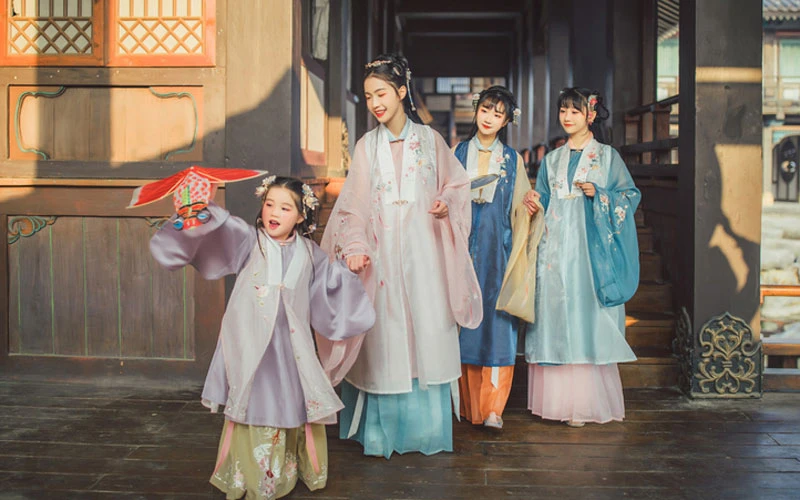
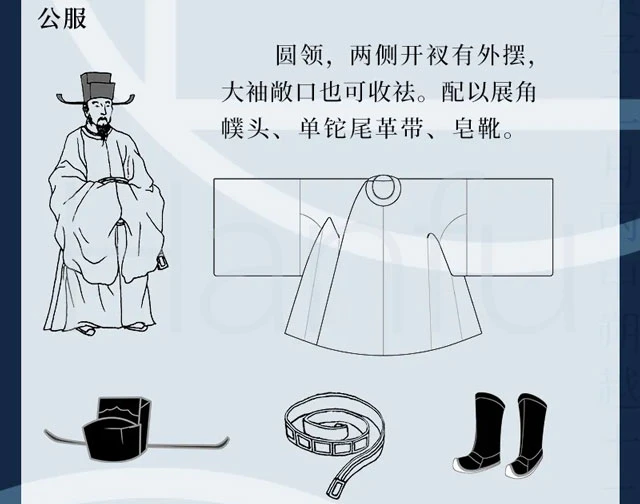
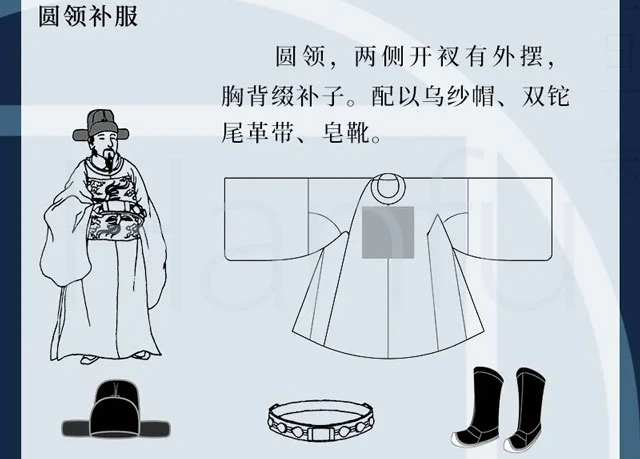
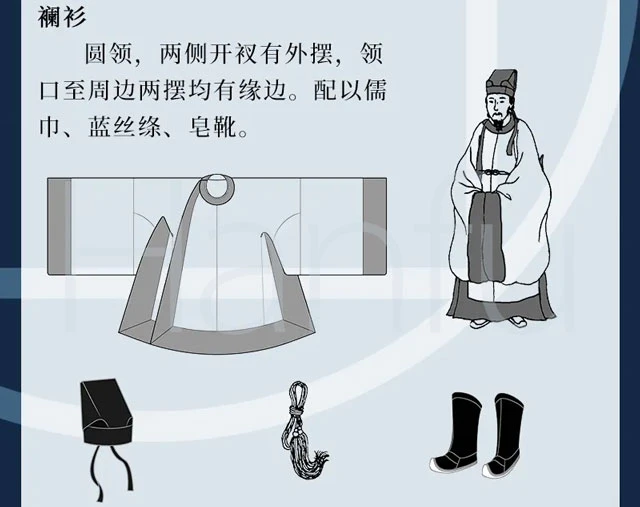
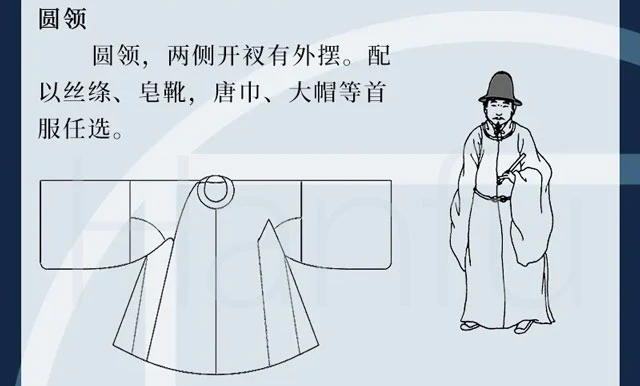
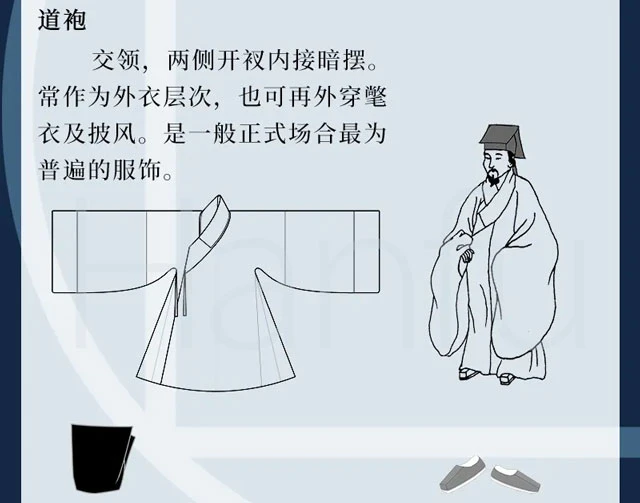
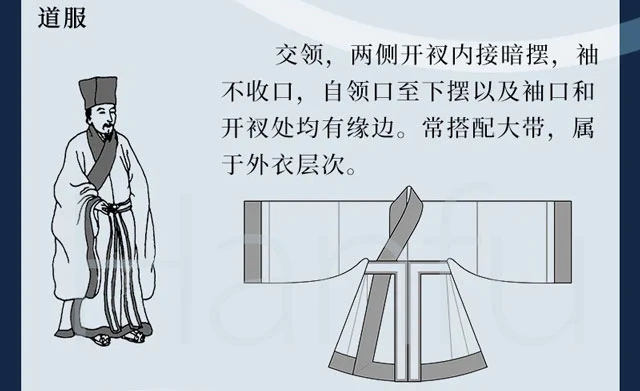
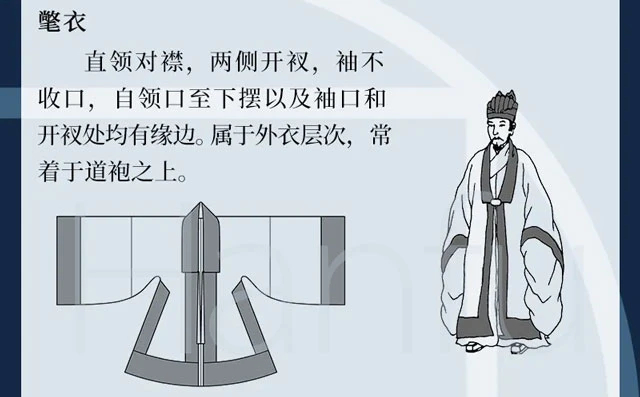
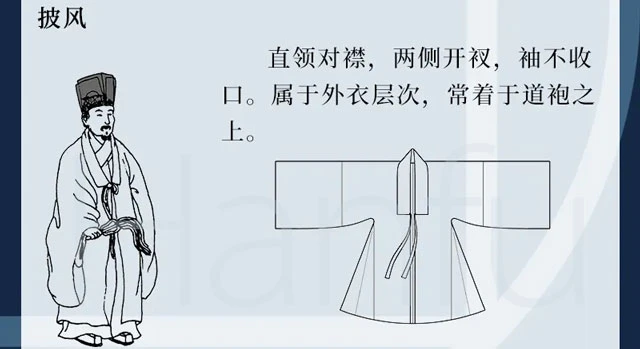
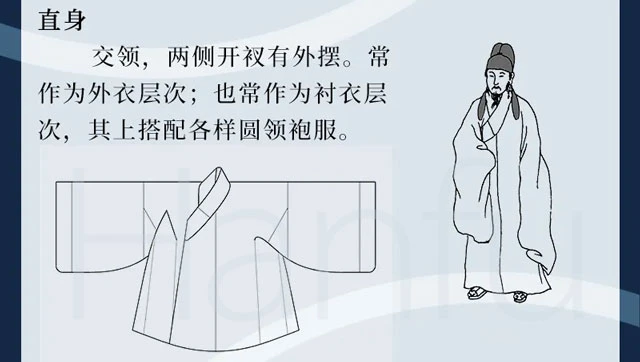
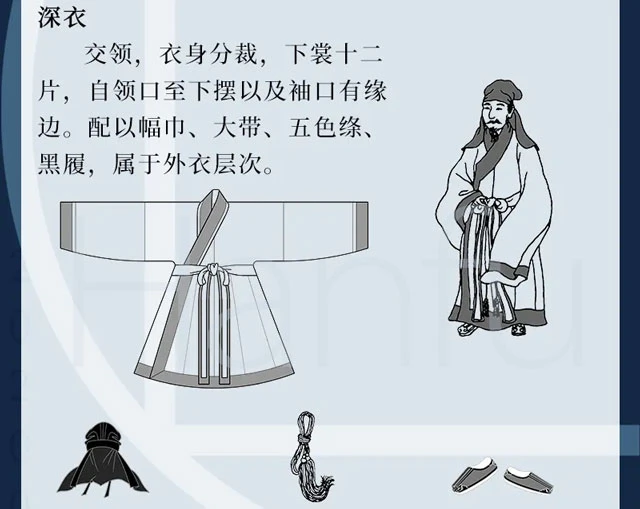
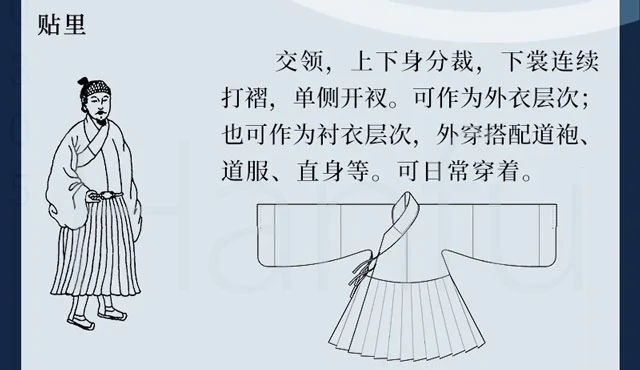
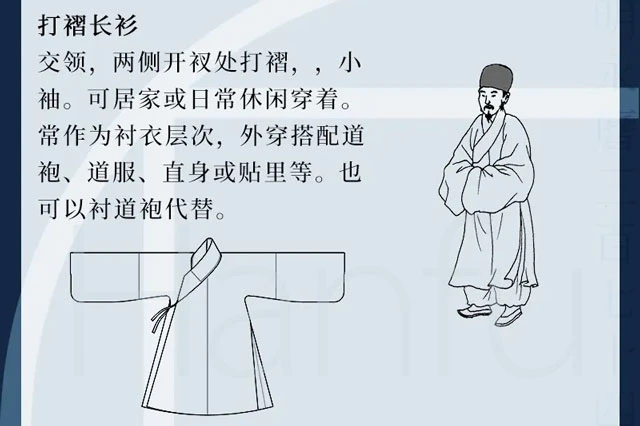
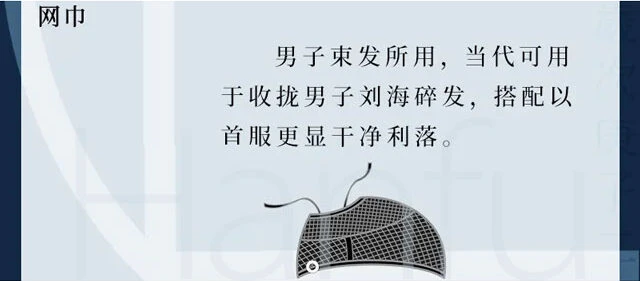
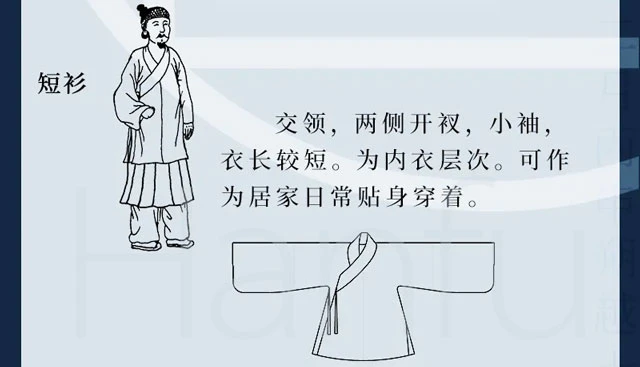
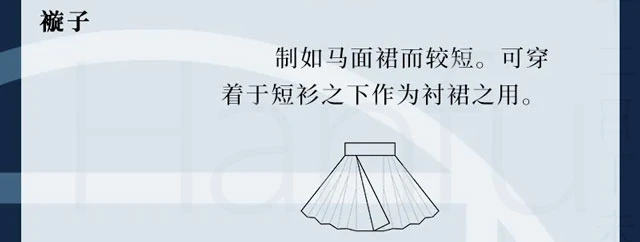
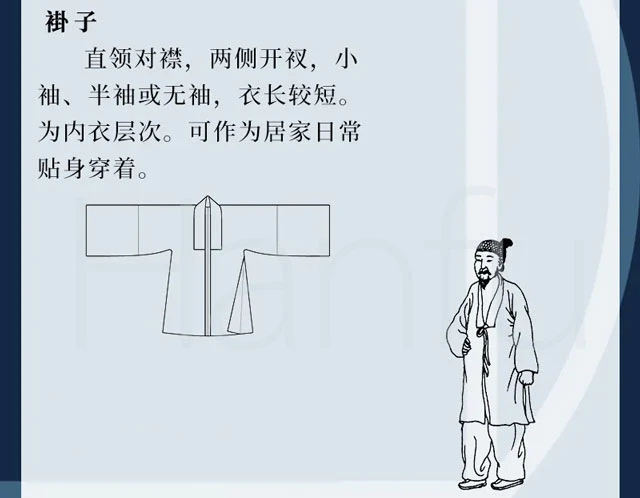
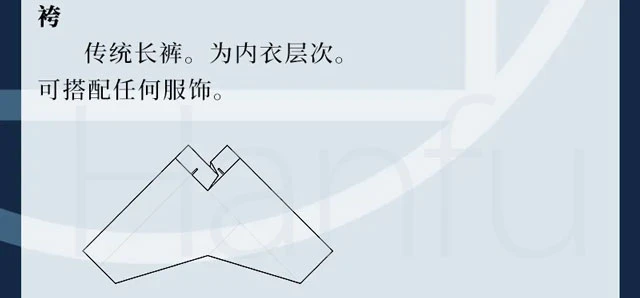
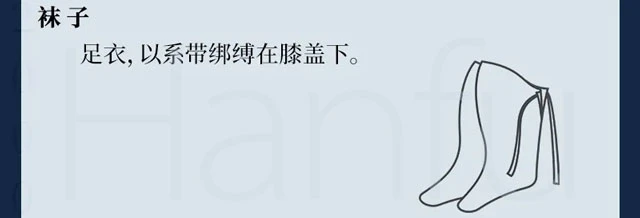
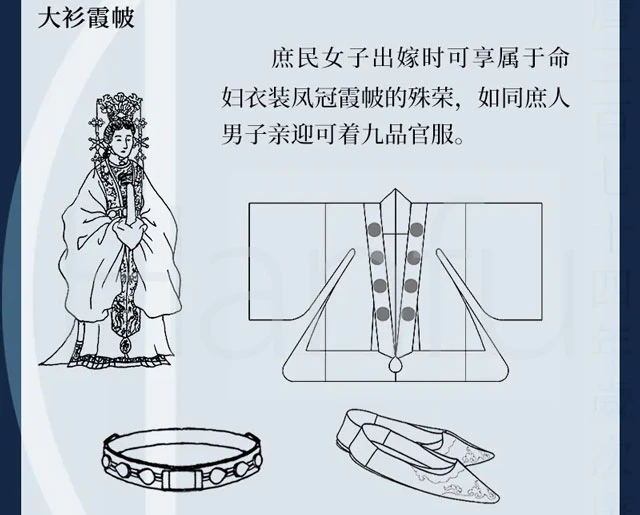
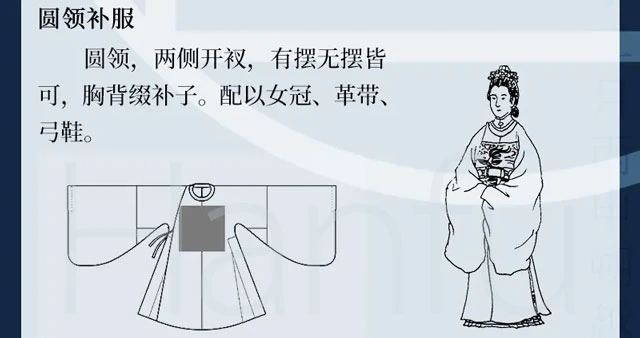
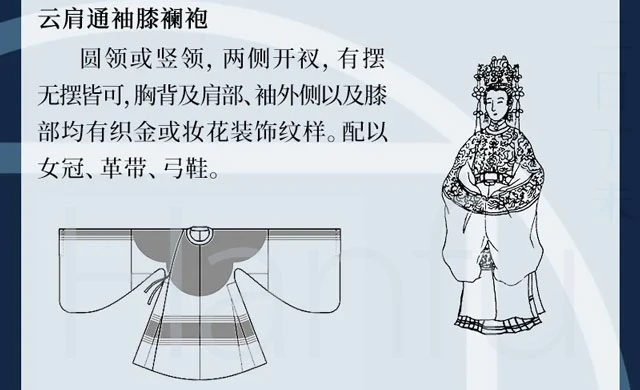
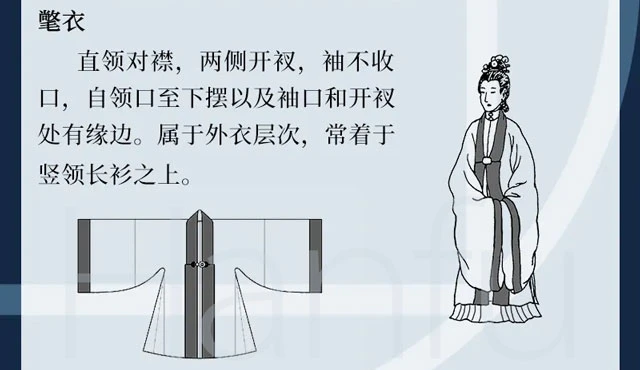
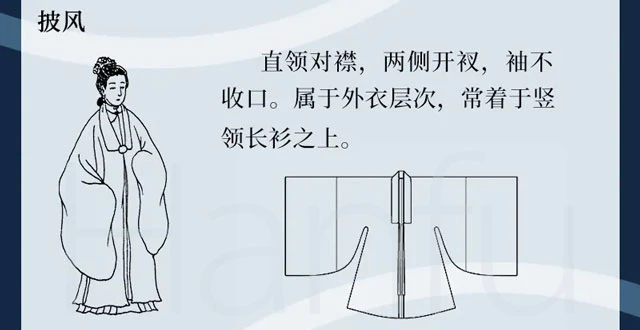
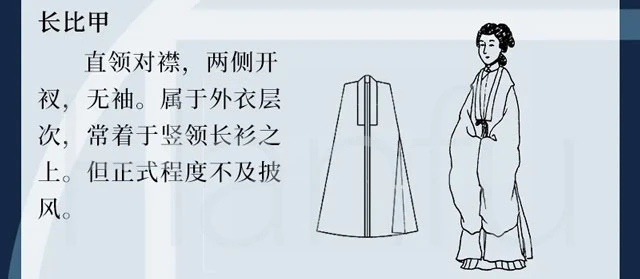
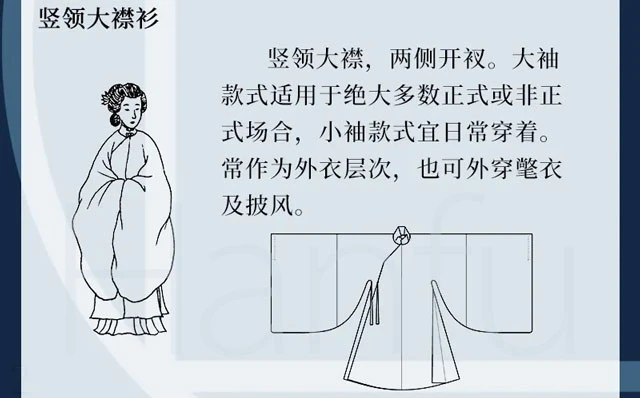
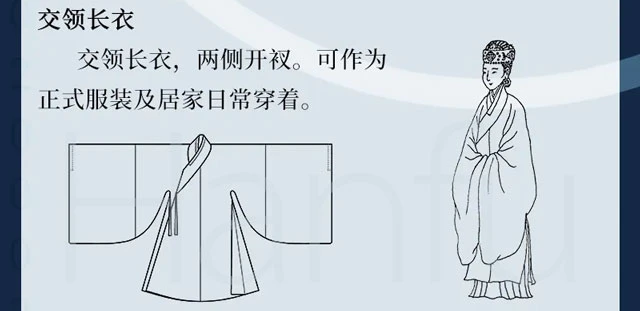
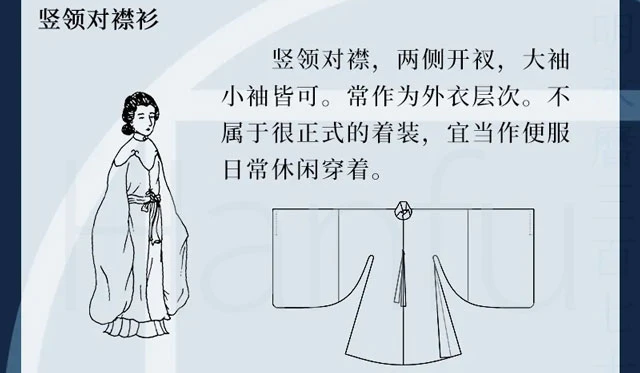
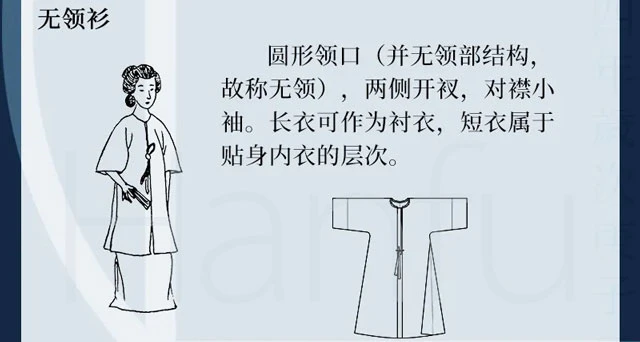
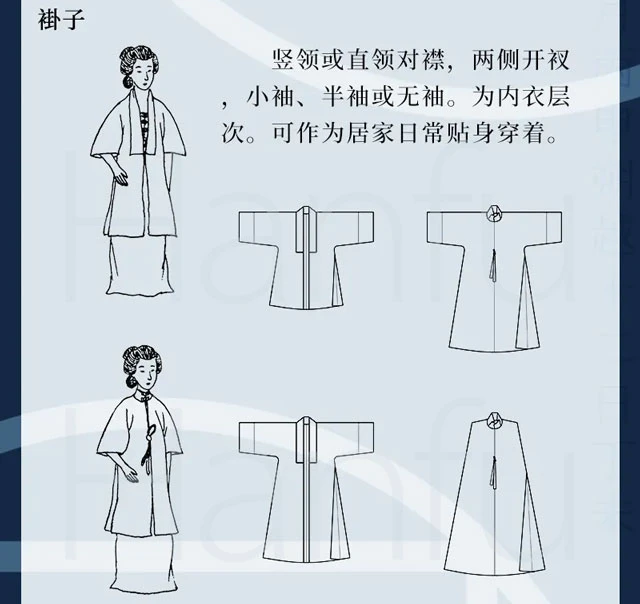
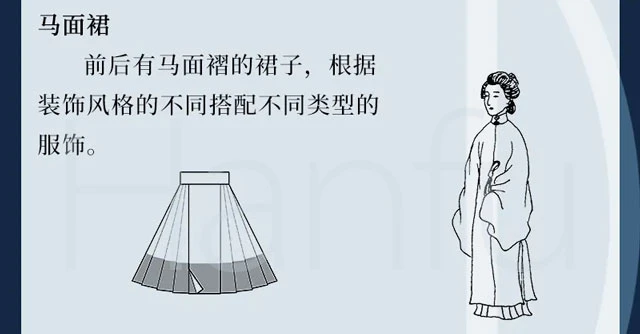
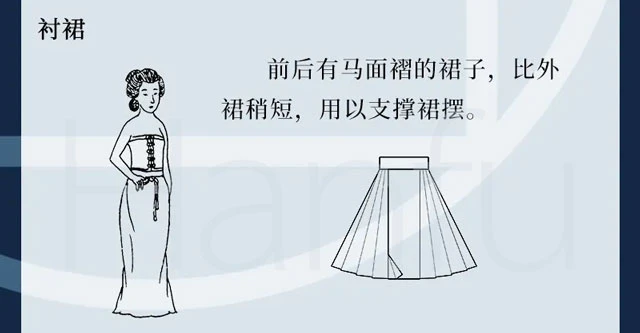
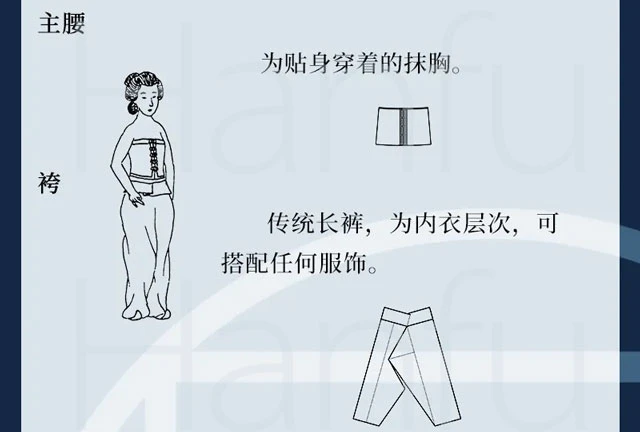
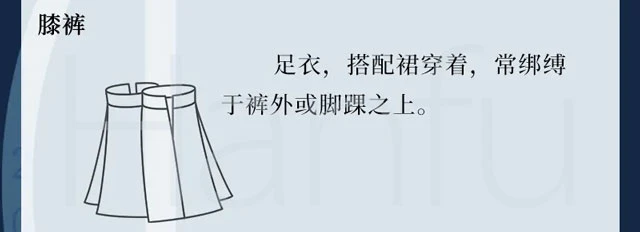
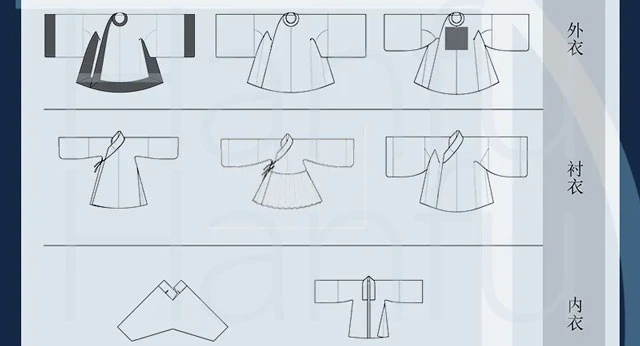
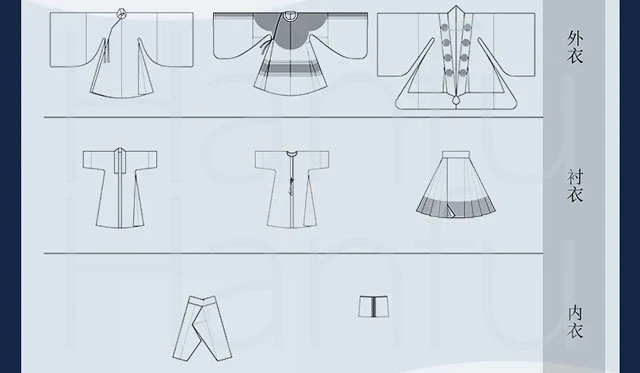
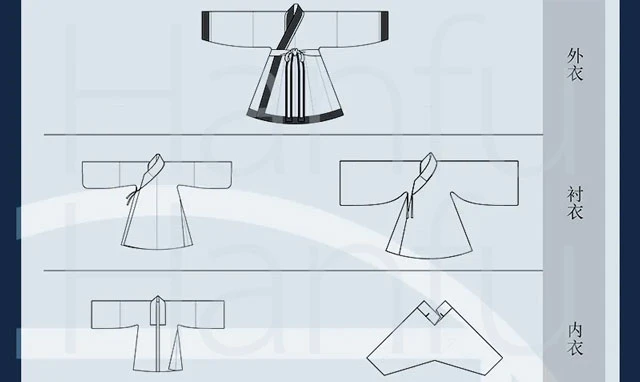
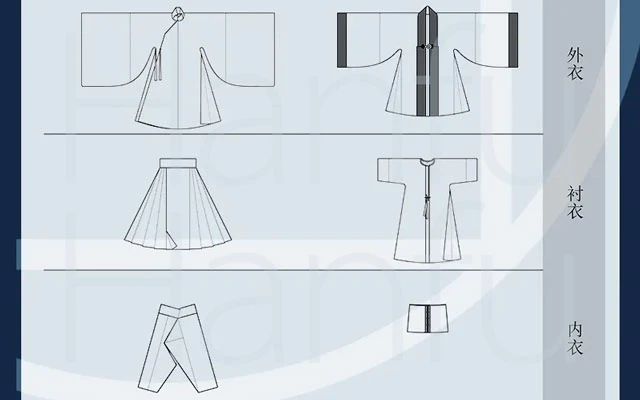
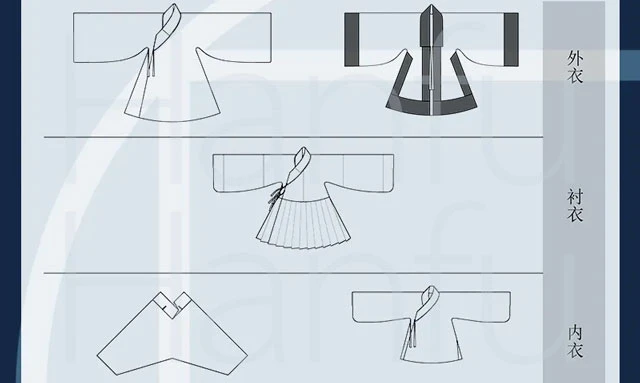
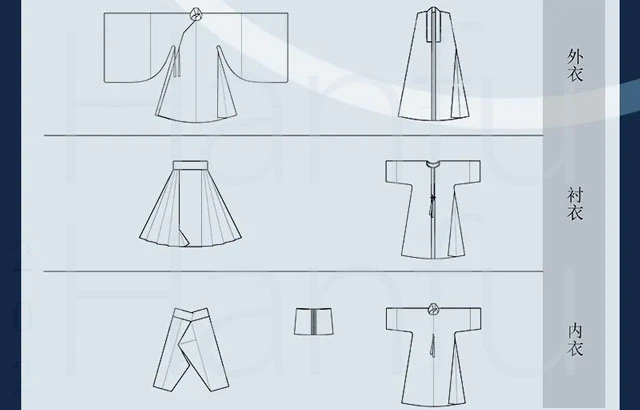
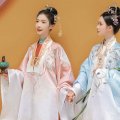

What's the difference between sleeveless guazi and bijia?
😍
Harus punya banyak baju nih untuk koleksi